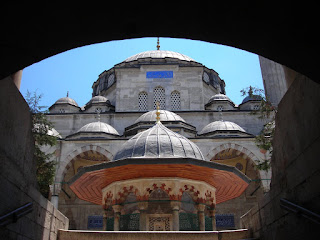
July 17, Friday: Istanbul: Time to let things wind down. Yesterday was a really busy day. We spent some excellent hours at Topkapi, and the later afternoon was mostly about getting ready to leave. This trip was a nice length -and the pause in Cirali in the middle of it all made it really work nicely. I am ready to not have to think too much about planning where to go each day; it will be nice to get home. Unfortunately, there is a long travel day in front of us. I think we pretty much stay at 4:30 PM (by the sun) for seven or eight hours.
That visit to Topkapi was really nice. We followed the plan from last year and were at the outer gate of the park (Babuhumaniye?) fifteen or twenty minutes before it all opened. If you play things just right, you can feel you have the place nearly to yourself for about one hour before the crowds really begin to flow into the palace. Also, we honed right in on the Harem (a seperate tour inside the palace), and that worked out perfectly. We effectively had the best rooms there to ourselves. Also, the basic layout of the palace made a lot more sense to me this time. You could see the hierarchical zones of eunuchs, concubines, Favorites, Valide Sultan (mother), Crowned Princes, Sultan with successively nicer hallways, courtyards and baths for each. My favorite place was the reading room off the chambers of Murad III (room designed by our hero, Sinan) – a beautifully ornamented, smaller sunny place overlooking all the waterways of Istanbul.
Topkapi is all about successive zones of beauty and privacy; it's not a European palace designed to overwhelm you with enormous galleries ornamented to impress. The rooms, although elaborately and beautifully decorated, are fairly small. The quantity of space that even a Sultan occupies is not that great. Meanwhile, in classic Ottoman style the inside flows onto the outside in many different gradations. It takes some imagination to recreate what the place would have been like when the many pools and water fountains were operating, and everything was draped with carpets and cushions.
We even had the time and endurance to make it through some of the museum galleries, seeing the clothing and jewels of the Sultans and the the vast collection of relics. I understand the clothing of the royals was considered nearly sacred. For generations (200 years, in fact) after he died, Suleyman's tomb was draped with his kaftans and turbans. The jewels were remarkable, although I must admit this stuff is not something I find particularly amazing. The “Spoon diamond” (one of the largest) was so called because it was found in a garbage pile and sold to a dealer for a few wooden spoons before being brought to the palace. Then there was the Topkapi dagger – and so it goes as you file past little case after little case.
The relics were much the same sort of experience. Was it the arm bones of John, the sauce pan of Abraham – or was that Abrahams arm and skull and John's staff – or Moses'. There also was also a run of gutterpipe from the Kabbaa – and a magnificent case you could view from two rooms away that contains the cloak of the Prophet.
Religion is incompatible with material reality. The world is truly composed merely of concepts. Sensation only particularlizes the abstract – nothing more.
An expensive but pleasant lunch just off the Hippodrome -then a nap and a scramble to pick up some turista stuff, and a goodbye at the carpet store where we had a pleasant talk about the Carpet biz with our guy, now that all the buying was (almost) done. Dinner at Buhara(?) 93, just down the street, another superlative salad and plate of roast meats.
This completes the 2009 edition of The Golden Horn. We will see what 2010 brings. My faithful assistant is already lobbying for a return. He feels he has invested too much work and practice into his Turkish language skills to simply leave things rest here. I am open to this, but my feeling is we need new travel companions. Now, having figured out the central mysteries of practical life here, we need to start our career as tourguides.
Most Remarable Thing: Well, when we were on the Sultan's pavilion, just outstide the Circumcision Kiosk, one of the tourists hauled off and kicked another in the pants. Delicacy forbids that I dwell on this or the ensuing brawl and arrests, but honesty demands that it was quite remarkable. It also reminded me of the aggravations of tourism. At that moment I decided that my travel experience had reached some sort of completion (depletion?).
Photo: Topkapi. This is the back of the Throne Room that is located just inside the Gate of Felicity where the Sultan received Ambassadors and other state visitors. The design and decoration shows the general ornamentation and feel of the palace.












